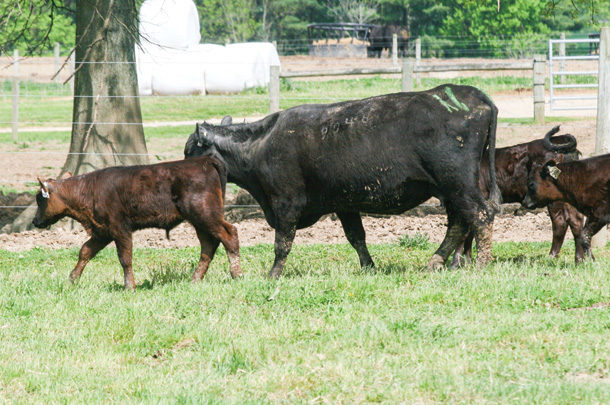While this is an important time to monitor cows and make sure calves get the ample colostrum they need to remain healthy, now is also the time to be thinking about future calving seasons.
A key component to productivity and, ultimately, profitability in a cow-calf operation is for each cow to wean one calf per year. The calving interval is the time between the birth of one calf and the subsequent birth of the next calf from the same cow. Shortening this interval through improved management can be advantageous in many ways and can lead to growing the profit potential within your cow herd.
1. Body condition
We talk about this one quite often and there is good reason for that. We demand a lot out of our cows, and if they don’t have the nutrition they need, they won’t perform to their potential. The condition of the cow herd should be monitored year-round. Nutrient requirements hit an all-time high during lactation. Typically, cows should be going into calving at a body condition score (BCS) of 5-6 on a nine-point scale. Putting on condition during lactation can be very costly and inefficient, however, it may be necessary to get cows bred back in a timely fashion. Setting the cow up during the second trimester, especially after her previous calf has been weaned, may be the best time (from an efficiency standpoint) to get condition put back on thinner cows.
To maintain a 12-month calving interval, we have 365 days. From there, we need to take away 283 days (the average length of gestation), leaving us with 82 days from the time she calves to when she needs to conceive again, and even less time if we are working to move her up in the calving season. Research has shown that the condition cows are in will negatively or positively affect the postpartum interval. The shorter a postpartum interval a cow has, the better chance she has to conceive earlier in the breeding season.
2. Mineral status
Reproductive efficiency and the mineral status of a herd typically go hand in hand. If mineral deficiencies occur over time, conception rates, days postpartum and the calving interval will be compromised. Phosphorus and vitamin E, in particular, will help assist in repairing the reproductive tract after calving and prepare cows to come into heat and breed back sooner.
Several self-fed supplement programs can be recommended both pre- and post-calving, such as supplements containing organic trace minerals. It is recommended to provide these supplements 45 days prior to calving, through the breeding period and 60 days prior to breeding replacement heifers.
Supplementing with organic trace minerals is also a great option for herds utilizing estrus synchronization and A.I. and for donor or recipient cows in an embryo transfer program. Many of these also have an optional formula available with mannan oligosaccharides (MOS) additives to help with overall health.
3. Additional management decisions
If maintaining a 12-month calving interval is challenging to achieve in your operation, think about what can be done differently to help attain this interval to maximize production. For some herds, moving the calving season may be the best option, allowing you to utilize the forages that may be available later on during the growing season. The time in which calves are weaned may also be something to consider, which can help to shorten the calving interval.
Early weaning may allow extra time for the cow herd to put on body condition if needed to conceive earlier in the breeding period next year. Also, evaluate your mineral program. Does the cow herd have access to minerals year round? Are they consuming it like they should be? Look for supplements that not only are palatable but also more bioavailable and readily absorbed.
Also, don’t forget about providing a high-quality mineral program to your bulls two to three months prior to turn out. Bulls that are reproductively sound will settle heifers and cows earlier in the breeding season, giving you an opportunity to tighten your calving window and benefit from a shorter calving interval.
The time to think about the breeding period and next year’s calves starts now. ![]()
PHOTO: Setting the cow up during the second trimester, especially after her previous calf has been weaned, may be the best time (from an efficiency standpoint) to get condition put back on thinner cows. Photo courtesy of Alltech.
-
Jill Peine
- Research and Nutrition Services
- Ridley Block Operations
- Email Jill Peine







